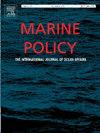为公海保护开辟一条变革性政策路线
IF 3.7
2区 社会学
Q2 ENVIRONMENTAL STUDIES
引用次数: 0
摘要
在国家管辖范围以外的区域(ABNJ)建立海洋保护区(MPAs)的进展,通常被称为“公海”,仍然受到三个高层次挑战的阻碍:(1)科学数据和知识的差距,(2)缺乏国际和区域能力,(3)制度障碍。在本研究中,我们根据之前的11个经验教训创建了一个新的比较框架,我们将这些经验教训归类于这三个挑战。我们使用该框架来比较区域海洋OSPAR委员会在2012年前后在ABNJ建立海洋保护区所采取的政策路线,以记录以前的经验教训,并确定政策过程中的任何变革性改进。我们发现,所有11个经验教训都得到了有力的吸收,并发生了许多转变,以克服科学数据、知识和能力方面的挑战。吸收的例子包括:使用多学科科学方法,推翻了ABNJ缺乏数据的概念;多个同时存在的政策驱动因素创造了巨大的势头和政治意愿;以及OSPAR与东北大西洋渔业委员会的集体安排。许多教训是相互依存的,特别是需要一个明确和透明的从科学到政策的过程。将未来的路线转变为在ABNJ建立海洋保护区,需要认识到这些相互依赖关系和气候变化和能力等经常性挑战,并在转型的基础上继续发展,包括使用大数据和人工智能,以及区域海洋委员会作为合作推动者的作用。本文章由计算机程序翻译,如有差异,请以英文原文为准。
Navigating a transformative policy route for High Seas conservation
Progress in establishing marine protected areas (MPAs) in areas beyond national jurisdiction (ABNJ), commonly referred to as the “High Seas”, remains delayed by three high level challenges: (1) gaps in scientific data and knowledge, (2) lack of international and regional capacity, and (3) institutional barriers. In the present study, we created a new comparative framework based on 11 previous lessons learned that we grouped across these three challenges. We used the framework to compare the policy routes that the regional seas OSPAR Commission took pre- and post-2012 to establish MPAs in ABNJ in order to document uptake of previous lessons and identify any transformative improvements in the policy process. We evidence strong uptake of all 11 lessons and many transformations taking place to overcome challenges in scientific data and knowledge and capacity. Examples of uptake included: using multidisciplinary scientific approaches that overturned the concept of ABNJ being data-poor; multiple concurrent policy drivers that created significant momentum and political will; and OSPAR’s Collective Arrangement with the North East Atlantic Fisheries Commission. Many lessons were interdependent, particularly the need for a clear and transparent science to policy process. Transforming future routes to establishing MPAs in ABNJ needs to recognise these interdependencies and recurrent challenges such as climate change and capacity, and build on transformations including the use of big data and artificial intelligence and the role of regional seas commissions as enablers of cooperation.
求助全文
通过发布文献求助,成功后即可免费获取论文全文。
去求助
来源期刊

Marine Policy
Multiple-
CiteScore
7.60
自引率
13.20%
发文量
428
期刊介绍:
Marine Policy is the leading journal of ocean policy studies. It offers researchers, analysts and policy makers a unique combination of analyses in the principal social science disciplines relevant to the formulation of marine policy. Major articles are contributed by specialists in marine affairs, including marine economists and marine resource managers, political scientists, marine scientists, international lawyers, geographers and anthropologists. Drawing on their expertise and research, the journal covers: international, regional and national marine policies; institutional arrangements for the management and regulation of marine activities, including fisheries and shipping; conflict resolution; marine pollution and environment; conservation and use of marine resources. Regular features of Marine Policy include research reports, conference reports and reports on current developments to keep readers up-to-date with the latest developments and research in ocean affairs.
 求助内容:
求助内容: 应助结果提醒方式:
应助结果提醒方式:


